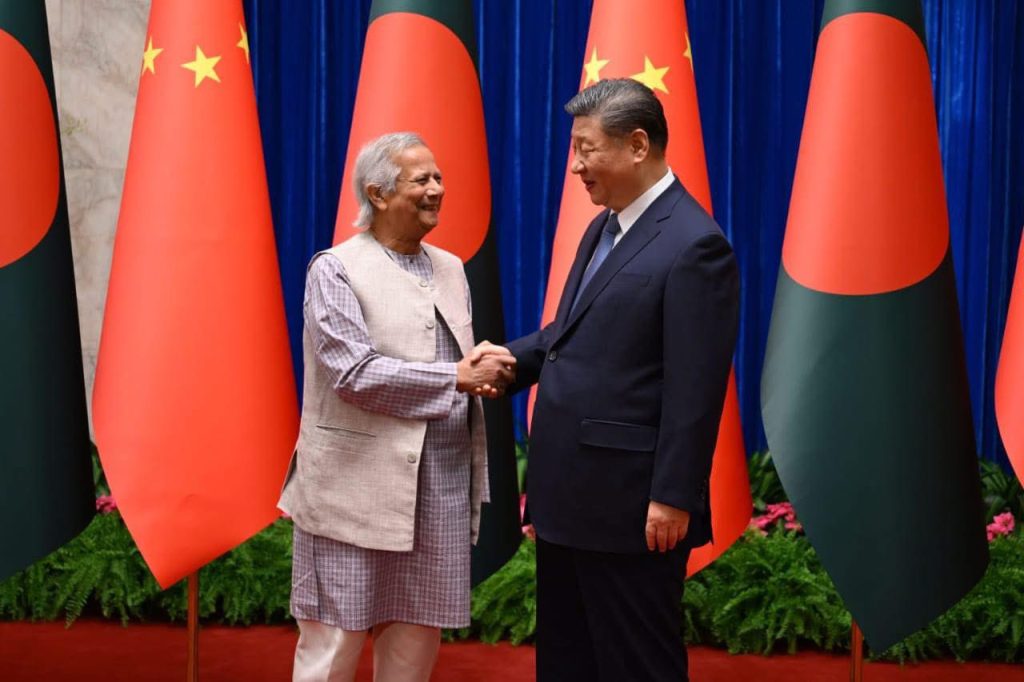When Bangladesh’s interim leader Muhammad Yunus touched down in Beijing in March 2025, few could have predicted the diplomatic quavers that would follow. Within days, his remarks caused a lot of discomfort in South Asia’s already fragile strategic milieu. His statement that India’s northeastern states were ‘landlocked’ and dependent on Bangladesh for access to the sea was widely interpreted as a geopolitical pointer: Dhaka was no longer merely leaning east—it was playing the China card with calculated intent. And all this while Sheikh Hasina, ousted from power in August 2024, remains in quiet exile in New Delhi.
The episode comes as a dramatic inflection point in India-Bangladesh ties. More importantly, it reveals a wider regional realignment in which old equations are being challenged, and South Asia’s smaller nations are rethinking their traditional dependencies.
From Visa Politics to Strategic Provocations
The souring of India-Bangladesh relations began almost immediately after Yunus assumed power. India’s decision to restrict medical visas for Bangladeshis in late 2024, cutting them from nearly 7,000 to under 1,000 per day, was officially justified by staffing constraints at the Indian High Commission in Dhaka. But few missed the subtext: Hasina’s ouster and India’s sheltering of the former premier had created a rift that Yunus’ administration was unwilling to ignore.
At the same time, Yunus courted Beijing with high-profile agreements, including Chinese support for reviving the Lalmonirhat airfield, located alarmingly close to India’s Siliguri Corridor. Yunus even floated the possibility of Pakistan participating as a subcontractor, raising India’s strategic alarm. The timing of India’s retaliatory move on April 8, 2025—cancelling a key transit facility that allowed Bangladesh to move exports through Indian territory to Bhutan, Nepal and Myanmar—made it clear that Dhaka’s provocations had not gone unanswered.
Playing the China Card
Faced with Indian pressure, Yunus is diversifying Bangladesh’s partnerships. His Beijing visit, timed with the 50th anniversary of Sino-Bangladesh ties, yielded pledges for investment in the Teesta River conservation project, new industrial parks, and even a proposed ‘friendship hospital’ in Dhaka. China, branding itself as a non-interfering alternative, has stepped in to fill the diplomatic and economic void.
This outreach is strategic. Unemployment among Bangladeshi youth hovers around 40%, and Yunus has little time to deliver results. His government is eyeing Chinese capital to jumpstart stalled development, positioning Dhaka as a logistics hub in the Bay of Bengal. China, for its part, sees an opening to expand its ‘String of Pearls’ infrastructure into yet another South Asian state.
India and China’s Reading of Dhaka’s New Role
From New Delhi’s standpoint, Yunus’ rhetoric in Beijing, and his openness to Chinese infrastructure projects near the Siliguri Corridor, are not just irritants but threats. Indian analysts fear that these developments could allow China to establish dual-use infrastructure near India’s sensitive northeast, echoing previous tensions in Doklam.
China, however, sees an opportunity. Its foreign ministry has emphasized ‘non-interference’ while quickly recognizing the interim government. In contrast to India’s cautious diplomacy, Beijing is offering fast-tracked investment and medical cooperation, including the recent arrival of Bangladeshi medical tourists in Yunnan.
Trade and Economic Ties
India’s decision to end the 2020 transit agreement has effectively removed a low-cost trade route for Bangladeshi exports to Nepal, Bhutan and Myanmar. This move, while couched in administrative language, is a strategic indicator. It impacts overland trade and undercuts Bangladesh’s garment industry, which had relied on Indian ports to access third-country markets.
More broadly, India’s $7 billion line of credit to Bangladesh, earmarked for rail, power, and defense infrastructure, has stalled. Several Indian-backed projects are now under review in Dhaka, while Chinese companies have invested over $230 million since August 2024 alone. India’s efforts to reassert its influence, such as the Kaladan Multi-Modal Project through Myanmar, face delays due to regional instability.
Message to South Asia
For South Asia’s smaller nations—Nepal, Bhutan, Maldives, and Sri Lanka—these developments carry a cautionary tale. India’s willingness to suspend key facilities over strategic concerns shows a shift from facilitator to gatekeeper. Meanwhile, China’s readiness to fill economic gaps without overt political conditions may prove attractive to leaders managing economic volatility or political uncertainty.
The ghost of past blockades is never far. In Nepal, memories of India’s 1989 and 2015 blockades continue to shape public discourse. Bhutan has experienced fuel subsidy withdrawals, and Sri Lanka, under President Wickremesinghe, remains cautious about over-dependence on either China or India. The Maldives, after a brief anti-India twist under former President Yameen, has realigned under Muizzu, but the pendulum could swing again.
A Region in Flux
The Yunus era, however short or transitional, is testing India’s neighbourhood policy. Dhaka’s assertiveness and openness to China reveal an uncomfortable truth: India’s regional goodwill cannot rest on history or sentiment alone. As connectivity becomes leverage and corridors become contested, South Asia is entering a new phase where strategic fencing may become the default position of smaller states.
India’s challenge is clear — to maintain its influence not through coercion or withdrawal, but through credible, responsive engagement. Failing that, the space will be filled by Beijing, or by a growing number of middle powers willing to do business with whoever’s in charge.
[Image Credit: X/@ChiefAdviserGoB]
The views expressed in this article are those of the author and do not necessarily reflect TGP’s editorial stance.

K.M. Seethi, Director, Inter University Centre for Social Science Research and Extension, is the Academic Advisor of the International Centre for Polar Studies at Mahatma Gandhi University, Kerala. He also served as ICSSR Senior Fellow, Senior Professor and Dean of International Relations at MGU.

